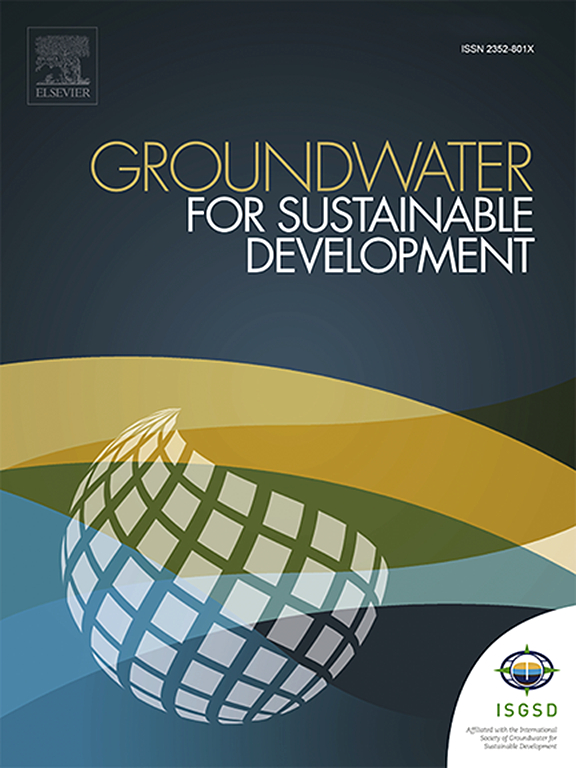应用 DRASTIC-LU/LC 方法与机器学习模型相结合,评估和预测 Rmel 含水层(摩洛哥西北部)的脆弱性
IF 4.9
Q2 ENGINEERING, ENVIRONMENTAL
引用次数: 0
摘要
Rmel 含水层位于摩洛哥西北部的丹吉尔-泰图安-胡塞马地区,面积约 240 平方公里,因人口增长和经济发展而面临日益严重的污染威胁。本研究评估了含水层易受污染的程度,并比较了与 DRASTIC-LU/LC 方法相结合的各种机器学习模型的性能。研究使用了 52 个分析硝酸盐浓度的水样数据集,考虑了影响脆弱性的八个因素:含水层深度、净补给量、含水层岩性、土壤质地、地形、浸润带影响、水力传导性和土地利用。采用信息增益测试来评估这些因素的重要性。DRASTIC-LU/LC 方法使用了四种机器学习算法:多层感知器 (MLP)、装袋算法 (BA)、K-近邻 (KNN) 和极随机树 (ERT)。模型性能通过 ROC 曲线下面积(ROC-AUC)进行评估,以衡量准确性。与 DRASTIC-LU/LC 相结合的 ERT 模型达到了最高的准确率(AUC = 0.929),其次是 BA(AUC = 0.925)、MLP(AUC = 0.852)和 KNN(AUC = 0.787)。相比之下,原始 DRASTIC-LU/LC 模型的 AUC 为 0.530。结果表明,整个 Rmel 含水层的易损性差异很大,南部和西北部地区的易损性水平较高到非常高,而东北部和中部地区的易损性水平中等到较低。通过比较水样中观测到的硝酸盐浓度,验证了易损性地图,确认了模型的准确性。地下水深度、净补给量和水力传导性被确定为影响脆弱性的最重要因素。这项研究证明了将机器学习模型与 DRASTIC-LU/LC 方法相结合进行精确含水层脆弱性评估的有效性,为公共政策和地下水管理提供了宝贵的工具。本文章由计算机程序翻译,如有差异,请以英文原文为准。

Application of the DRASTIC-LU/LC method combined with machine learning models to assess and predict the vulnerability of the Rmel aquifer (Northwest, Morocco)
The Rmel aquifer, located in the Tangier-Tetouan-Al Hoceima region of northwest Morocco, covers approximately 240 km2 and faces increasing pollution threats due to population growth and economic development. This study assesses aquifer vulnerability to pollution, and compares the performance of various machine learning models integrated with the DRASTIC-LU/LC method. The research used a dataset of 52 water samples analyzed for nitrate concentrations, considering eight factors influencing vulnerability: aquifer depth, net recharge, aquifer lithology, soil texture, topography, vadose zone impact, hydraulic conductivity, and land use. An information gain test was applied to evaluate the importance of these factors. Four machine learning algorithms were used with the DRASTIC-LU/LC method: multilayer perceptron (MLP), the bagging algorithm (BA), K-nearest neighbors (KNN), and extremely randomized trees (ERT). Model performance was assessed via the area under the ROC curve (ROC-AUC) to measure accuracy. The ERT model combined with DRASTIC-LU/LC achieved the highest accuracy (AUC = 0.929), followed by BA (AUC = 0.925), MLP (AUC = 0.852), and KNN (AUC = 0.787). In comparison, the original DRASTIC-LU/LC model had an AUC of 0.530. The results highlight significant vulnerability variation across the Rmel aquifer, with high to very high levels in the southern and northwestern regions, and moderate to low levels in the northeast and central areas. Vulnerability maps were validated by comparing the observed nitrate concentrations in the water samples, confirming model accuracy. Groundwater depth, net recharge, and hydraulic conductivity were identified as the most significant factors influencing vulnerability. This study demonstrates the effectiveness of integrating machine learning models with the DRASTIC-LU/LC method for accurate aquifer vulnerability assessment, offering valuable tools for public policy and groundwater management.
求助全文
通过发布文献求助,成功后即可免费获取论文全文。
去求助
来源期刊

Groundwater for Sustainable Development
Social Sciences-Geography, Planning and Development
CiteScore
11.50
自引率
10.20%
发文量
152
期刊介绍:
Groundwater for Sustainable Development is directed to different stakeholders and professionals, including government and non-governmental organizations, international funding agencies, universities, public water institutions, public health and other public/private sector professionals, and other relevant institutions. It is aimed at professionals, academics and students in the fields of disciplines such as: groundwater and its connection to surface hydrology and environment, soil sciences, engineering, ecology, microbiology, atmospheric sciences, analytical chemistry, hydro-engineering, water technology, environmental ethics, economics, public health, policy, as well as social sciences, legal disciplines, or any other area connected with water issues. The objectives of this journal are to facilitate: • The improvement of effective and sustainable management of water resources across the globe. • The improvement of human access to groundwater resources in adequate quantity and good quality. • The meeting of the increasing demand for drinking and irrigation water needed for food security to contribute to a social and economically sound human development. • The creation of a global inter- and multidisciplinary platform and forum to improve our understanding of groundwater resources and to advocate their effective and sustainable management and protection against contamination. • Interdisciplinary information exchange and to stimulate scientific research in the fields of groundwater related sciences and social and health sciences required to achieve the United Nations Millennium Development Goals for sustainable development.
 求助内容:
求助内容: 应助结果提醒方式:
应助结果提醒方式:


